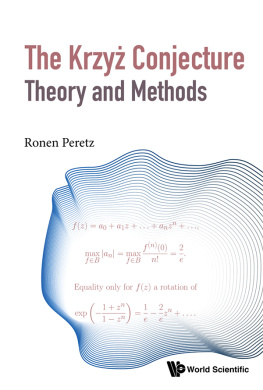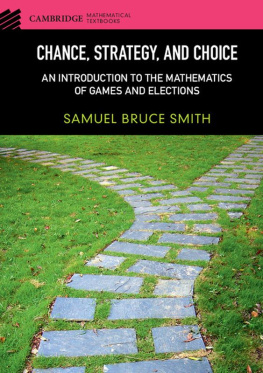ADVENTURES IN MATHEMATICAL REASONING
SHERMAN STEIN
DOVER PUBLICATIONS, INC.
MINEOLA, NEW YORK
Copyright
Copyright 2001 by Sherman Stein
All rights reserved.
Bibliographical Note
Adventures in Mathematical Reasoning, first published by Dover Publications, Inc, in 2016, is an unabridged republication of How the Other Half Thinks: Adventures in Mathematical Reasoning, originally published in 2001 by McGraw-Hill, Inc., New York.
Library of Congress Cataloging-in-Publication Data
Names: Stein, Sherman K.
Title: Adventures in mathematical reasoning / Sherman Stein.
Other titles: How the other half thinks
Description: Mineola, New York : Dover Publications, Inc., 2016. | Originally
published as: How the other half thinks : adventures in mathematical reasoning / Sherman Stein (New York : McGraw-Hill, 2001). | Includes bibliographical references and index.
Identifiers: LCCN 2016015004| ISBN 9780486806440 | ISBN 0486806448 Subjects: LCSH: MathematicsPopular works.
Classification: LCC QA93 .S675 2016 | DDC 510dc23 LC record available at https://lccn.loc.gov/2016015004
Manufactured in the United States by RR Donnelley
80644801 2016
www.doverpublications.com
Contents
Preface
O ccasionally, in some difficult musical compositions there are beautiful, but easy partsparts so simple a beginner could play them. So it is with mathematics as well.
There are some discoveries in advanced mathematics that do not depend on specialized knowledge, not even on algebra, geometry, or trigonometry. Instead they may involve, at most, a little arithmetic, such as "the sum of two odd numbers is even," and common sense. Each of the eight chapters in this book illustrates this phenomenon. A layperson can understand every step in the reasoning.
One of my purposes in writing this book is to give readers who haven't had the opportunity to see and enjoy real mathematics the chance to appreciate the mathematical way of thinking. I want to reveal not only some of the fascinating discoveries, but, more important, the reasoning behind them.
In that respect, this book differs from most books on mathematics written for the general public. Some present the lives of colorful mathematicians. Others describe important applications of mathematics. Yet others go into mathematical reasoning, but assume that the reader is adept in using algebra.
The thinking in each chapter uses at most only elementary arithmetic, and sometimes not even that. Thus all readers will have the chance to participate in a mathematical experience, to appreciate the beauty of mathematics, and to become familiar with its logical, yet intuitive, style of thinking. This is a book of mathematics, not a book about it.
A word about the chapters that involve random events, such as a tossed penny coming up heads or tails: We will use phrases such as "the odds of getting a heads is 1/2" or "in the long run we expect about 50 percent of the tosses to be heads." The precise meaning of such phrases has been the subject of extensive research by statisticians. We will interpret the phrases intuitively, much as William Feller did in An Introduction to Probability and Its Applications. As he put it, "[E]veryone has acquired a feeling for the meaning of statements such as 'the chances are three in five.' Vague as it is, the intuition serves as a background and guide."
Each chapter begins with a simple question about strings made up of two letters, usually a and b. The opening question may lead to others, which are answered in the course of the chapter. Strings of letters may arise in many ways, for instance, from the wins and losses of a baseball team, the heads and tails of a tossed penny, or the pulses and no-pulses of an electronic stream of data. Some originate in chance events, some in carefully planned arrangements.
Typical of this approach is transmitting confidential information and checking the reliability of a computer. Thus, while my primary goal is to illustrate the mathematical way of thinking, if a particular result has applications, so much the better.
I hope this book will help bridge that notorious gap that separates the two cultures: the humanities and the sciences, or should I say the right brain (intuitive, holistic) and the left brain (analytical, numerical). As the chapters will illustrate, mathematics is not restricted to the analytical and numerical; intuition plays a significant role. The alleged gap can be narrowed or completely overcome by anyone, in part because each of us is far from using the full capacity of either side of the brain. To illustrate our human potential, I cite a structural engineer who is an artist, an electrical engineer who is an opera singer, an opera singer who published mathematical research, and a mathematician who publishes short stories.
Other scientists have written books to explain their fields to outsiders, but have necessarily had to omit the mathematics, although it provides the foundation of their theories. The reader must remain a tantalized spectator rather than an involved participant, since the appropriate language for describing the details in much of science is mathematics, whether the subject is the expanding universe, subatomic particles, or chromosomes. Though the broad outline of a scientific theory can be sketched intuitively, when a part of the physical universe is finally understood, its description often looks like a page in a mathematics text.
Still, the nonmathematical reader can go far in understanding mathematical reasoning. This book presents the details that illustrate the mathematical style of thinking, which involves sustained, step-by-step analysis, experiments, and insights. You will turn these pages much more slowly than when reading a novel or a newspaper. It may help to have pencil and paper ready to check claims and carry out experiments.
As I wrote, I kept in mind two types of readers: those who enjoyed mathematics until they were turned off by an unpleasant episode, usually around fifth grade; and mathematics aficionados, who will find much that is new throughout the book.
This book also serves readers who simply want to sharpen their analytical skills. Many careers, such as law and medicine, require extended, precise analysis. Each chapter offers practice in following a sustained and closely argued line of thought. That mathematics can help develop this skill is shown by these two testimonials:
A physician wrote, "The discipline of analytical thought processes [in mathematics] prepared me extremely well for medical school. In medicine one is faced with a problem which must be thoroughly analyzed before a solution can be found. The process is similar to doing mathematics."
A lawyer made the same point, "Although I had no background in lawnot even one political science courseI did well at one of the best law schools. I attribute much of my success there to having learned, through the study of mathematics, and, in particular, theorems, how to analyze complicated principles. Lawyers who have studied mathematics can master the legal principles in a way that most others cannot."
I hope you will share my delight in watching as simple, even naive, questions lead to remarkable solutions and purely theoretical discoveries find unanticipated applications.
Sherman Stein
Acknowledgments
The broader its intended audience, the harder it is to write the book. For this reason, I made sure that the various drafts of the manuscript were read by several people who well represented the readers I had in mind. Max Massie, a bookman, Larry Snyder, a musician and musicologist, and Joshua Stein, a lawyer, made countless improvements in the exposition. My wife, the poet Hannah Stein, not only repaired sentences and rearranged paragraphs, but kept me human during the month upon month I spent at my desk. The mathematicians George Raney and G. Donald Chakerian substantially clarified the exposition.
Next page











